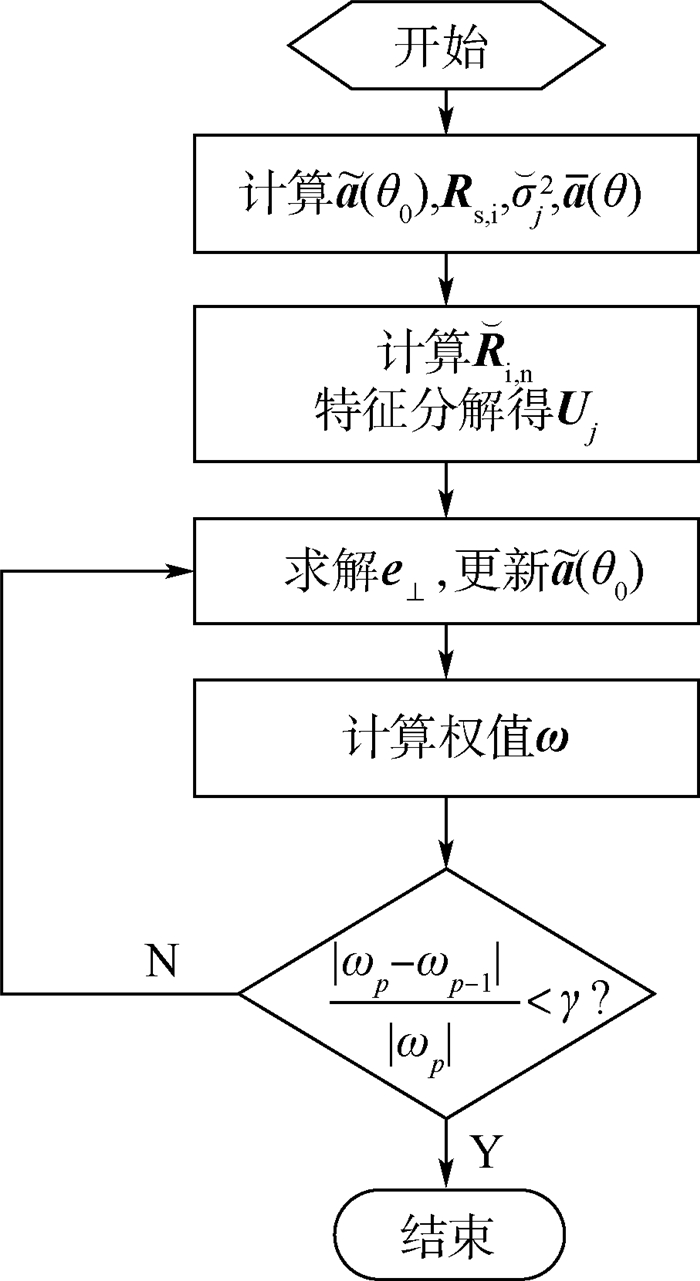A robust beamforming algorithm based on double-layer reconstruction of covariance matrix
-
摘要:
针对协方差矩阵含目标信号分量及目标导向矢量失配情况下,传统自适应波束形成器性能急剧下降的问题,提出了干扰加噪声协方差矩阵双层重构的稳健波束形成算法。首先,利用稀疏重构的方法预估干扰加噪声协方差矩阵,通过估计干扰导向矢量及干扰功率对干扰加噪声协方差矩阵进行优化校正;然后,基于子空间理论建立导向矢量约束误差优化模型,利用迭代方法对凸优化模型进行求解,得到最优权值向量。仿真结果表明:所提算法显著提高了波束形成器在目标导向矢量约束误差及阵列误差情况下的稳健性,低快拍条件下表现较好,输出性能优于仿真对比算法。
-
关键词:
- 自适应波束形成 /
- 干扰与噪声协方差矩阵 /
- 双层重构 /
- 导向矢量估计 /
- 迭代求解
Abstract:Focusing on the problem that the performance of traditional adaptive beamformer declines sharply when the covariance matrix contains the target signal component and the target steering vector mismatch, a robust beamforming algorithm based on double-layer reconstruction of interference-plus-noise covariance matrix is proposed in this paper. Firstly, sparse reconstruction method is used to estimate interference-plus-noise covariance matrix. The interference-plus-noise covariance matrix is optimized by estimating the interference steering vector and interference power. Secondly, based on subspace theory, an optimization model of steering vector constraint error is established, and the convex optimization model is solved by iterative method to obtain the optimal weight vector. The simulation results show that the proposed algorithm improves the robustness of the beamformer in the case of target vector constraint error and array error. The algorithm performs well in low-speed snapshot and its output performance is better than the existing methods.
-
表 1 收敛速度统计
Table 1. Convergence rate statistics
Tmax 运行时间/ms γ=10-2 γ=10-3 γ=10-4 γ=10-5 γ=10-6 20 71.4 91.1 121.8 30 159.6 40 243.3 -
[1] HUANG L, ZHANG J, XU X, et al. Robust adaptive beamforming with a novel interference-plus-noise covariance matrix reconstruction method[J]. IEEE Transactions on Signal Processing, 2015, 63(7): 1643-1650. doi: 10.1109/TSP.2015.2396002 [2] CARLASON B D. Covariance matrix estimation errors and diagonal loading inadaptive arrays[J]. IEEE Transactions on Aerospace and Electronic Systems, 1988, 24(7): 397-401. http://ieeexplore.ieee.org/document/7181/references [3] COX H, ZESKING R M, OWEN M H. Robust adaptive beamforming[J]. IEEE Transactions on Acoustic, Speech, Signal Processing, 1987, 35(10): 1365-1376. doi: 10.1109/TASSP.1987.1165054 [4] LEI Y, FAN Y Q, WEI Y S, et al. Robust adaptive beamforming method for large-scale array with automatic diagonal loading and steering vector estimation[J]. The Journal of Engineering, 2019, 2019(21): 8047-8050. doi: 10.1049/joe.2019.0762 [5] ZHANG X, ZHUANG L H, LIU W W, et al. Acoustic beamforming through adaptive diagonal loading[C]//Proceedings of the 2019 IEEE Symposium on Product Compliance Engineering. Piscataway: IEEE Press, 2019: 104-111. [6] 毛晓军. 高性能阵列天线稳健自适应波束形成技术研究[D]. 哈尔滨: 哈尔滨工程大学, 2017.MAO X J. Study on the high performance robust adaptive beamforming in antenna arrays[D]. Harbin: Harbin Engineering University, 2017(in Chinese). [7] HUANG Y W, ZHOU M K, SERGIY A. New designs on MVDR robust adaptive beamforming based on optimal steering vector estimation[J]. IEEE Transactions on Signal Processing, 2019, 67(14): 3624-3638. doi: 10.1109/TSP.2019.2918997 [8] ZHUANG J, YE Q, TAN Q, et al. Low-complexity variable loading for robust adaptive beamforming[J]. Electronics Letters, 2016, 52(5): 338-340. doi: 10.1049/el.2015.3844 [9] STOICA P, WANG Z, LI J. Robust Capon beamforming[J]. IEEE Signal Processing Letters, 2003, 10(6): 172-175. doi: 10.1109/LSP.2003.811637 [10] LI J, STOICA P, WANG Z S. On robust Capon beamforming and diagonal loading[J]. IEEE Transactions on Signal Processing, 2003, 51(7): 1702-1715. doi: 10.1109/TSP.2003.812831 [11] MAO X, LI W, LI Y, et al. Robust adaptive beamforming against signal steering vector mismatch and jammer motion[J]. International Journal of Antennas & Propagation, 2015, 2015: 1-12. [12] GU Y J, LESHEM A. Robust adaptive beam forming based on interference covariance matrix reconstruction and steering vector estimation[J]. IEEE Transactions on Signal Processing, 2012, 60(7): 3881-3885. doi: 10.1109/TSP.2012.2194289 [13] HUANG J S, SU H T, YANG Y. Robust adaptive beamforming for MIMO radar in the presence of covariance matrix estimation error and desired signal steering vector mismatch[J]. IET Radar, Sonar & Navigation, 2020, 14(1): 118-126. http://ieeexplore.ieee.org/document/8979623/ [14] LU Z, LI Y, GAO M, et al. Interference covariance matrix reconstruction via steering vectors estimation for robust adaptive beamforming[J]. Electronics Letters, 2013, 49(22): 1373-1374. doi: 10.1049/el.2013.2070 [15] WANG Y S, BAO Q L, CHEN Z P. Robust adaptive beamforming using IAA-based interference-plus-noise covariance matrix reconstruction[J]. Electronics Letters, 2016, 52(13): 1185-1186. doi: 10.1049/el.2015.4420 [16] 杨志伟, 张攀, 陈颖, 等. 导向矢量和协方差矩阵联合迭代估计的稳健波束形成算法[J]. 电子与信息学报, 2018, 40(12): 2874-2880. https://www.cnki.com.cn/Article/CJFDTOTAL-DZYX201812012.htmYANG Z W, ZHANG P, CHEN Y, et al. Steering vector and covariance matrix joint iterative estimations for robust beamforming[J]. Journal of Electronics & Information Technology, 2018, 40(12): 2874-2880(in Chinese). https://www.cnki.com.cn/Article/CJFDTOTAL-DZYX201812012.htm [17] ZHENG Z, ZHENG Y, WANG W Q, et al. Covariance matrix reconstruction with interference steering vector and power estimation for robust adaptive beamforming[J]. IEEE Transactions on Vehicular Technology, 2018, 67(9): 8495-8503. doi: 10.1109/TVT.2018.2849646 [18] AMAR A, DORON M A. A linearly constrained minimum variance beamformer with a pre-specified suppression level over a pre-defined broad null sector[J]. Signal Processing, 2015, 109(1): 165-171. http://dl.acm.org/citation.cfm?id=2801368 [19] ZHUANG J, HUANG P. Robust adaptive array beamforming with subspace steering vector uncertainties[J]. IEEE Signal Processing Letters, 2012, 19(12): 785-788. doi: 10.1109/LSP.2012.2221709 [20] YUAN X, GAN L. Robust algorithm against large look direction error for interference-plus-noise covariance matrix reconstruction[J]. Electronics Letters, 2016, 52(6): 448-450. doi: 10.1049/el.2015.3716 [21] ZHANG Y, LI Y, GAO M. Robust adaptive beamforming based on the effectiveness of reconstruction[J]. Signal Processing, 2016, 120: 572-579. doi: 10.1016/j.sigpro.2015.09.039 -







 下载:
下载:











